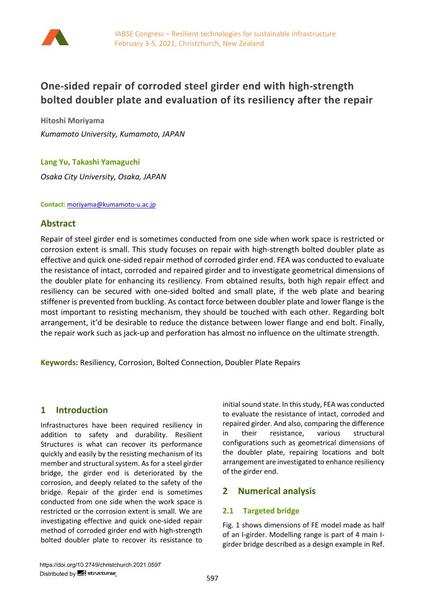One-sided repair of corroded steel girder end with high-strength bolted doubler plate and evaluation of its resiliency after the repair

|
|
|||||||||||
Détails bibliographiques
| Auteur(s): |
Hitoshi Moriyama
(Kumamoto University, Kumamoto, JAPAN)
Lang Yu (Osaka City University, Osaka, JAPAN) Takashi Yamaguchi (Osaka City University, Osaka, JAPAN) |
||||
|---|---|---|---|---|---|
| Médium: | papier de conférence | ||||
| Langue(s): | anglais | ||||
| Conférence: | IABSE Congress: Resilient technologies for sustainable infrastructure, Christchurch, New Zealand, 3-5 February 2021 | ||||
| Publié dans: | IABSE Congress Christchurch 2020 | ||||
|
|||||
| Page(s): | 597-604 | ||||
| Nombre total de pages (du PDF): | 8 | ||||
| DOI: | 10.2749/christchurch.2021.0597 | ||||
| Abstrait: |
Repair of steel girder end is sometimes conducted from one side when work space is restricted or corrosion extent is small. This study focuses on repair with high-strength bolted doubler plate as effective and quick one-sided repair method of corroded girder end. FEA was conducted to evaluate the resistance of intact, corroded and repaired girder and to investigate geometrical dimensions of the doubler plate for enhancing its resiliency. From obtained results, both high repair effect and resiliency can be secured with one-sided bolted and small plate, if the web plate and bearing stiffener is prevented from buckling. As contact force between doubler plate and lower flange is the most important to resisting mechanism, they should be touched with each other. Regarding bolt arrangement, it’d be desirable to reduce the distance between lower flange and end bolt. Finally, the repair work such as jack-up and perforation has almost no influence on the ultimate strength. |
||||
